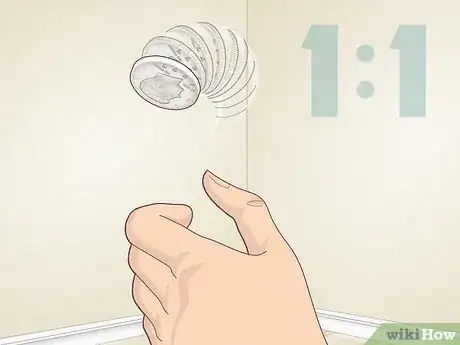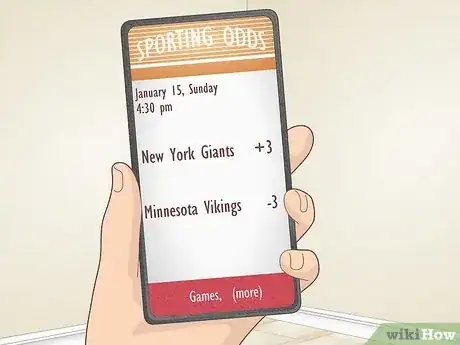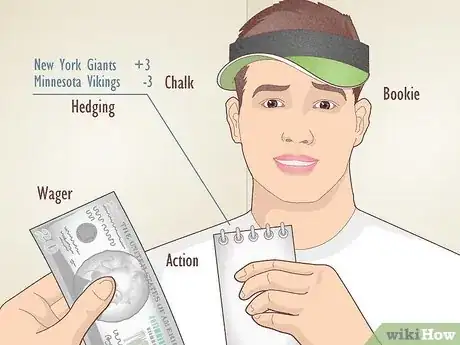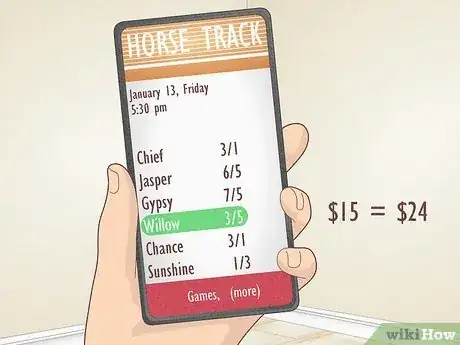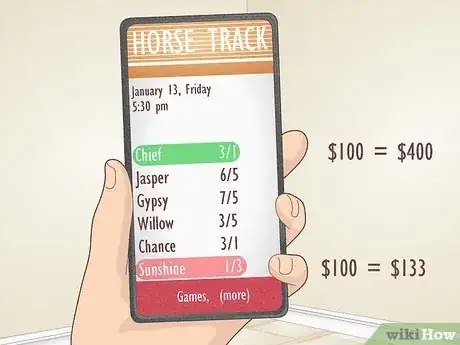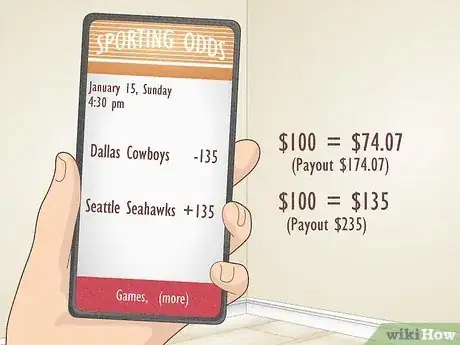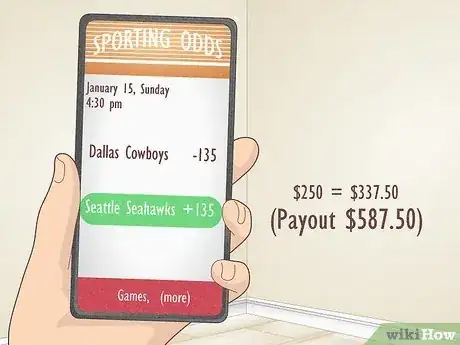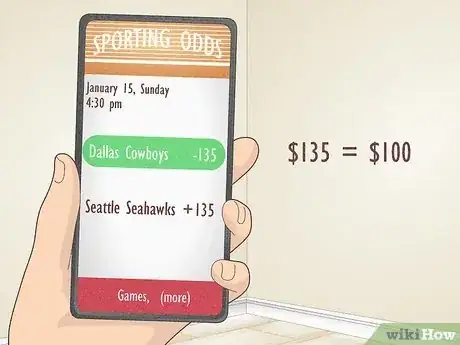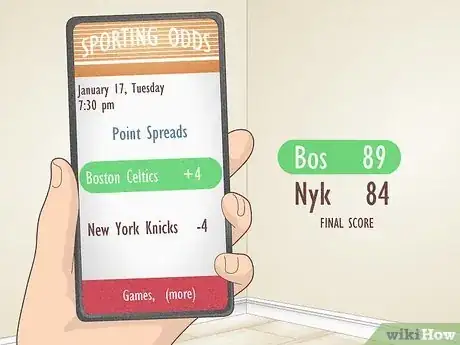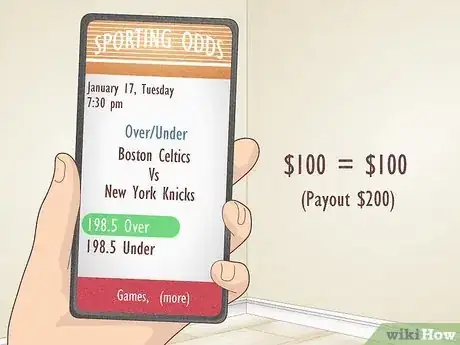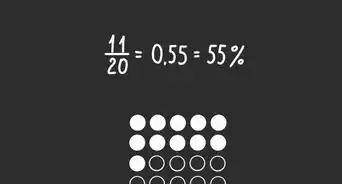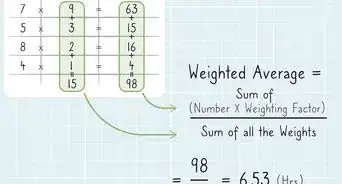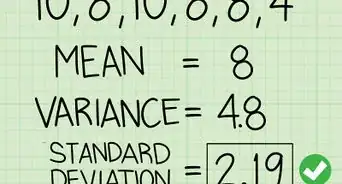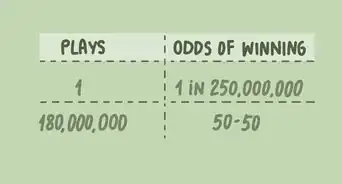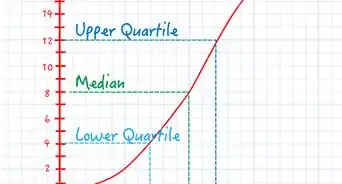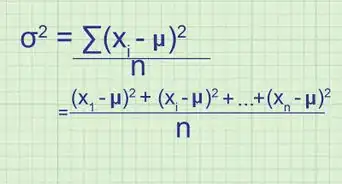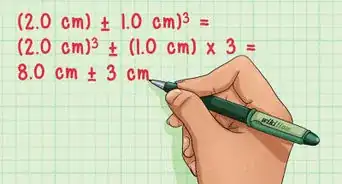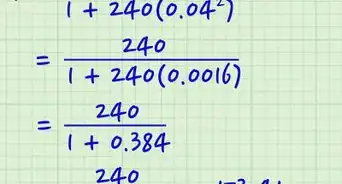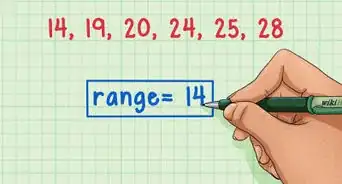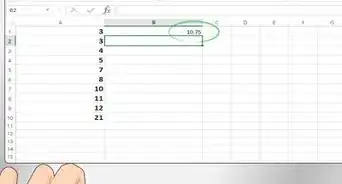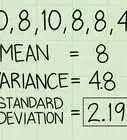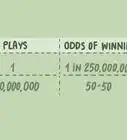This article was co-authored by David Jia. David Jia is an Academic Tutor and the Founder of LA Math Tutoring, a private tutoring company based in Los Angeles, California. With over 10 years of teaching experience, David works with students of all ages and grades in various subjects, as well as college admissions counseling and test preparation for the SAT, ACT, ISEE, and more. After attaining a perfect 800 math score and a 690 English score on the SAT, David was awarded the Dickinson Scholarship from the University of Miami, where he graduated with a Bachelor’s degree in Business Administration. Additionally, David has worked as an instructor for online videos for textbook companies such as Larson Texts, Big Ideas Learning, and Big Ideas Math.
This article has been viewed 978,727 times.
If you bet on sporting events, you must be able to read odds and understand what they mean. Furthermore, you need to quickly calculate the potential winnings for different bets, especially if the odds are changing while the event unfolds. Odds tell you the likelihood that an event will occur (a team wins, a boxer makes it a certain round) and how much will be paid out if you win. There are, however, multiple ways to convey this information.
Things You Should Know
- Odds at horse tracks tell you the profit you’ll make per dollar spent. If this ratio is greater than 1, it means the team is an underdog.
- For moneyline bets, positive odds indicate how much profit you win per $100 spent and negative odds indicate how much you must spend to make $100.
- Ask about the “vig” in point spreads and over/under odds. This is the amount you need to bet to win a $100 profit.
Steps
Understanding Odds
-
1Know that odds tell you the likelihood of an outcome. Odds represent which team, horse, or athlete has the highest probability of winning. While there are different ways to write odds, they all indicate how likely one outcome is in comparison to another.[1]
- Ex: When I flip a coin, it is just as likely that I flip heads as tails. The odds are equal, or one to one.
- Ex: If there is an 80% chance of rain one day, then there is a 20% chance it will not rain as well. The odds are 80 to 20. Otherwise put, it is four times more likely that it will rain than stay sunny.
- Because circumstances may change spontaneously, odds may change as well. They are not an exact science.
-
2Read sporting odds as the likelihood that one team, athlete, or horse, will win. The most common use of odds is found when placing a bet on a sporting event. Betting agencies use historical data and team statistics to predict who is more likely to win.
- Whoever has the highest odds is considered the "favorite." If the odds are low, it means that event is not likely to occur.
Advertisement -
3Remember that lower odds return a higher profit. Betting on the underdog is riskier than betting on a favorite, but a higher risk means a higher potential reward.
- The "longer the odds," or the less likely, the more money you could win.
-
4Learn the vocabulary of odds when betting. Many racetracks and betting establishments will have a booklet or pamphlet helping you learn terminology, but you should understand the lingo before you read odds. Some of the basic words include:[2]
- Action: A bet or wager of any kind or amount.
- Bookie: Someone who accepts bets and sets odds.
- Chalk: The favorite.
- Hedging: Placing bets on the team with the high odds, and the low odds, to minimize loss.
- Line: On any event, the current odds or point spreads on the game.
- Wager: The money you pay, or risk, on an outcome or event.
Reading Odds at the Horse Track
-
1Know that odds at the track tell you amount of profit you will make per dollar spent. Odds of 3-5 indicate that your profit will be three-fifths of a dollar. In other words, for every $5 you bet you can win $3 in profit.
- To determine profit, multiply the amount you bet by the fraction. If I spend $15, then my profit for winning is $9 (15 x 3/5).
- Ex. If I successfully bet $15 on a horse with 3/5 odds of winning, the payout would be $24 ($15 + [15 x 3/5])
-
2Understand that fractions greater than one mean a team is an underdog. This makes sense, because you would expect a bet on the underdog to have a higher payout.
- If you have a hard time with fractions, then see if there is a larger number on top then on bottom. If so, that team/horse is not expected to win.
- When you bet for the underdog, it is called betting "against the odds." For example, if odds are 3/1 for the Cowboys this Sunday, then it is three times more likely that they will lose than win.
- Odds of 3-1 indicate that if you bet $100, you will win $400, the original amount of your bet plus the profit. Odds of 1-3 will win you $33 on a $100 bet, or $133.
Reading Moneyline Odds
-
1Know that moneyline bets only concern what team will win the game. Odds are presented as a positive or negative number next to the team's name. A negative number means the team is favored to win, while a positive number indicates that they are the underdog.
- Ex: Dallas Cowboys, -135; Seattle Seahawks, +135. This means the Cowboys are the favorites, but pay out less money if a bet on them wins.
- Try out an online to check your math when you first get started. Soon enough it will be second nature, but for now ask a friend or search for a calculator that fits your betting needs.
-
2Know that positive odds indicate how much profit you win per $100 spent. You also get the money you bet back. So when you bet $100 on the Seahawks, who are valued at +135, then you make $235 if they win.[3]
- If you bet $200, you will make twice as much profit. To calculate how much profit you make per dollar spent, divide the amount you are going to spend by 100.
- Multiply this number by the moneyline to see your potential profit. If I spend $50, I will make .5 (50/100) of the moneyline if I win. On +135 odds, I would make $67.50 profit off of a winning bet.
- Ex: If I spend $250 on the Seahawks (+135), I would earn $587.50 ($250 + $135 x [$250/$100]) if they win.
-
3Understand that negative odds indicate how much money your must spend to make $100. When betting on the favorite, you take less risk, and thus earn less. When betting on a favorite, the moneyline is the amount of money you need to spend to make $100 profit. In the previous example, in order to make $100 of profit betting for the Cowboys, you would need to spend $135. Like positive odds, you earn back your bet when winning.[4]
- To calculate profit, divide 100 by the moneyline to find out the profit made per dollar spent. If the moneyline is -150, then you will make $.66 for every dollar you bet (100/150).
- Ex: If the New York Giants are favored to win -150, and I spend $90, I would make $150 total ($90 + $90 x [100/150]).
Reading a Point Spread
-
1Notice that point spreads adjust the score for the favorite team. This is easiest to see with an example: If the New York Knicks are playing the Boston Celtics, and Boston is favored to win by a 4-point spread, then a bet on Boston only pays out if Boston wins by more than 4 points. A bet on New York pays out if New York wins or if they lose by less than 4 points.[5]
- If the favorite wins by the spread exactly, it is called a "push" and all bets are refunded. In the example, if Boston wins 88-84, then it is a push and no one collects a profit.
- If you see "half-odds" (a 4.5-point spread, for example), this is to make a "push" impossible.
- When the spread is small, moneyline bets are often better since the spread does not indicate a clear underdog.
-
2Ask your bookie about the "vig," which determines your potential profit. Also known as the "juice," the vigorish is the commission charged for placing a bet. Typically the vig is -110, and you read this number like a moneyline bet (see above).[6]
- On a vig of -110, I must bet $110 to make a $100 profit.
- Continuing the example above, say I placed $110 on Boston, and they win 96-90 on a 4-point spread. Because they won by the spread, I would make $210 ($110 + $100).
- Sometimes there are different vigs for each team. A line from before might look like this: Boston -6, -125; New York +6, -110. This means you have to bet $125 on Boston to earn $100 because there is less risk betting on Boston.
Reading Over/Under Odds
-
1Know that Over/Under bets are placed on the combined score of both teams and are much simpler to place. A bookie sets the Over/Under, and you simply choose if the combined score will be higher or lower than that mark. Over/Under bets are often less risky and complicated than other forms of betting.[7]
- If the O/U is 198.5 points and you bet over, then any combined score from 199 points and up will pay out.
- If the score is exactly what the bookies set, then the bet is a push and everyone gets their money back.
-
2Most payouts for Over/Under bets are even, meaning that if you wager $100 you win $100 profit.
- Make sure to check this with your bookie first, however.
Community Q&A
-
QuestionWhat does -13, for example, mean in football?
 Community AnswerThe "-13" means that a football team is favored to win by 13 points. For you to win the bet, the team must win by more than 13 points.
Community AnswerThe "-13" means that a football team is favored to win by 13 points. For you to win the bet, the team must win by more than 13 points. -
QuestionIf the odds are 5/3, and I bet $100, what is the payout if I win?
 Community Answer5/3 odds equates to a +166 money line bet, meaning a $100 bet would return $266 (your original $100 bet plus $166).
Community Answer5/3 odds equates to a +166 money line bet, meaning a $100 bet would return $266 (your original $100 bet plus $166). -
QuestionWhat does it mean if, in the presidential election, I see one candidate with a 175 and another with a +225?
 Community AnswerThe 175 should read -175. (-) means you pay and (+) means you get. So for -175 you pay $175 to get $100 (in addition of your initial bet $275 in total) and for +225 you get $225 when you bet $100 ($325 in total).
Community AnswerThe 175 should read -175. (-) means you pay and (+) means you get. So for -175 you pay $175 to get $100 (in addition of your initial bet $275 in total) and for +225 you get $225 when you bet $100 ($325 in total).
References
- ↑ https://dictionary.cambridge.org/us/dictionary/english/odds
- ↑ https://www.espn.com/chalk/story/_/id/11457015/betting-glossary-common-betting-terms
- ↑ https://www.thelines.com/betting/moneyline/
- ↑ https://www.thelines.com/betting/moneyline/
- ↑ https://www.thelines.com/betting/point-spread/
- ↑ https://www.thelines.com/betting/point-spread/
- ↑ https://www.thelines.com/betting/over-under-total/
About This Article
To read odds, start by finding 2 numbers separated by a dash. These 2 numbers are the odds, and you can turn them into a fraction to figure out the amount of profit you will make per dollar spent. For example, you might see 3-5 odds. Odds of 3-5 indicate that your profit will be three-fifths of a dollar. In other words, for every $5 you bet you can win $3 in profit. To figure out profit, multiply the amount you bet by the odds fraction. To learn about moneyline odds and point spreads, read on!
